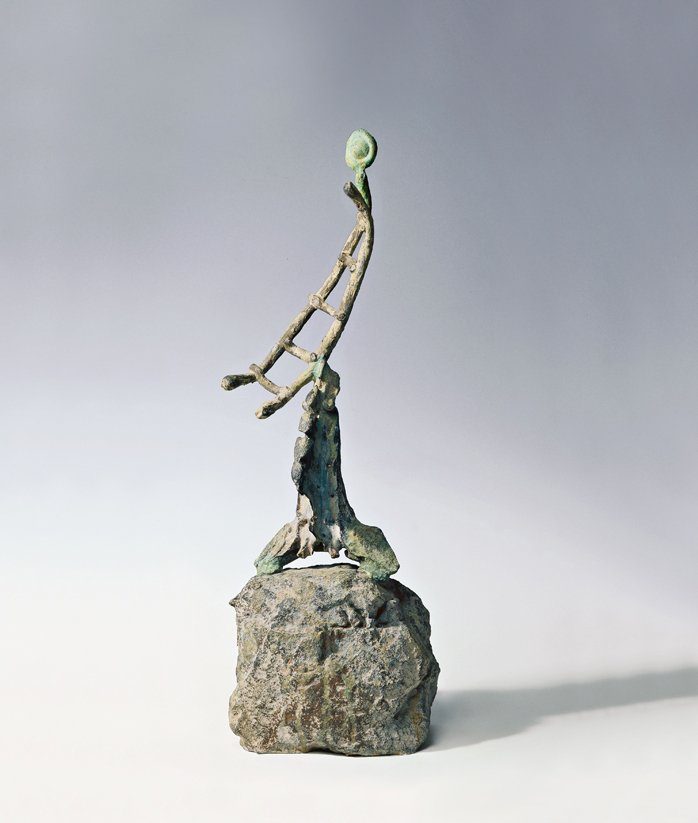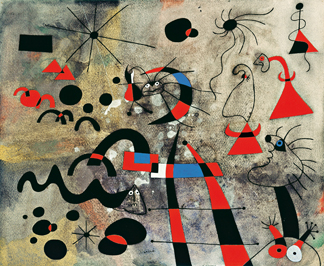Share |
Art Review: Joan Miró: The Constellations
By Ina Cole
ART TIMES May/ June 2011
 Joan Miró, The Ladder of the Escaping Eye (1971), Bronze, Fundació Joan Miró, Barcelona, © Successió Miró/ADAGP, Paris and DACS, London 2011 |
IN 1939 THE Catalan painter Joan Miró (1893-1983) left Paris for Varengeville-sur-Mer in Normandy, and it was here an important new body of work was formed – a series of twenty-three gouaches, which became known as the Constellations. They are amongst the artist’s most intricately constructed works, exploring ideas linked to the transformative processes located within the natural world – the regeneration of butterfly hoards, the migration of birds, the ebb and flow of tides, and the tracks of constellations and galaxies. The mysteries of the universe provide a challenge that has preoccupied artists and scientists through time, in their search to find meaning in the ubiquitous presence of the intangible. The Constellations, which were created during a particularly harrowing period in world history – the Second World War – are optimistic, even joyous, and can be viewed as an emblem of hope at a time of intense military and political turmoil.
The Constellations reveal a mastery of observation in relation to the artist’s ability to capture the minutiae of natural phenomena. As the overriding title suggests, the series depicts a microcosm of life revolving in space, with the individual titles of works particularly evocative – Woman beside a lake whose surface has been made iridescent by a passing swan; The nightingale’s song at midnight and morning rain; People in the night guided by the phosphorescent tracks of snails; and The passage of the divine bird. The Constellations fuse Miró’s interests into a coherent whole, while creating a complex balance of forms that reflect on the fragile, illusory nature of existence. On viewing the work one’s breath is held in anticipation, for fear that a false move could bring this imaginary world to collapse. In 1959 Miró wrote eloquently about the pictorial order in his works, saying, “In my paintings there is a kind of circulatory system. If even one form is out of place, the circulation stops; the balance is broken”.
The Escape Ladder, a signature work from this series, was painted shortly before Miró left for Spain, as a consequence of the Germans opening bombardments in the district of Varengeville-sur-Mer. In this work blacks are applied to a background of muted tones, with the primary colours – predominantly reds and blues – determined by the black contours and silhouettes. Biomorphic forms are introduced, free flowing and buoyant, simultaneously humanoid, animal, arthropod and amphibian, emerging from their location deep within the imagination. Their faces peer from the canvas through spherical eyes, amid the rotating primordial shapes of the pyramid, sphere and cube. A ladder, the key element that gives the work its name, is positioned just off-centre, and soars to a crescent moon. The ladder provides a structure to the work, creating the necessary equilibrium that gives a sense of order to the levitating forms occupying the picture space, as well as further emphasising the feeling of ascension.
 Joan Miró, The Escape Ladder (1940), Gouache, watercolour and ink on paper, Museum of Modern Art, New York, © Successió Miró/ADAGP, Paris and DACS, London 2011 Joan Miró, The Escape Ladder (1940), Gouache, watercolour and ink on paper, Museum of Modern Art, New York, © Successió Miró/ADAGP, Paris and DACS, London 2011 |
On fleeing Varengeville-sur-Mer, Miró boarded a train carrying a portfolio containing the first of the Constellations, including The Escape Ladder. He completed the series in Spain during the war years, a time when he lived and worked in virtual isolation. The Constellations represent a fantastical world of imagery, truly unique in the history of twentieth-century art. Scale is dissolved and the picture space is populated with regions that contain both the wonders and the terrors of the infinite. The series speaks a bewildering language, yet manages to instinctively engage the senses on a subliminal level. The forms are strongly suggestive of reflections in water; indeed at this time Miró lived on the outskirts of Palma, Mallorca, where he spent hours contemplating the sea. In these works incomprehensible mutations occupy the same space, and these organisms unite to create a seemingly utopian existence in an unfathomable location, which could equally be planet earth, the ocean floor, or even the realms of outer space.
In 1945 the Constellations were smuggled out of Europe by diplomatic pouch for an exhibition at the Pierre Matisse Gallery in New York. The series was hailed as the first artistic message to arrive from Europe since the fall of France. In fact, it was in America that Miró felt able to fully secure the success that had previously eluded him. He became key to the development of a practise that was associated with no clear representational aim, but the direct communication of the subconscious mind. This was known as automatism, and its revival became one of the central facets of Surrealist art in the United States, playing a significant role in the liberation of post-war American abstraction in the early 1940s. The Constellations directly inspired the emerging American Abstract Expressionist painters who, at the time, were seeking to escape from the constraints of Social Realism and Regionalism.
On a personal level, the Constellations represented a sense of freedom for Miró, following the anguished peintures sauvages of the 1930s, but for the Americans they offered a new compositional order, with the concept of a set of works as a series establishing a groundbreaking precedent in art during the 1950s. It was perhaps the American painter, Robert Motherwell, who most vividly expressed his views on the importance of Miró and his work: “I like everything about Miró – his clear-eyed face, his modesty, his ironically-edged reticence as a person, his constant hard work, his Mediterranean sensibility, and other qualities that manifest themselves in a continually growing body of work that for me, is the most moving and beautiful now being made in Europe. A sensitive balance between nature and man’s work, almost lost in contemporary art, saturates Miró’s art, so that his work, so original that hardly anyone has any conception of how original, immediately strikes us to the depths” (Miró in America, 1982).
In the Constellations Miró viewed the interdependence of the great and small as a network that holds the world in balance, and he had an innate understanding of the multifaceted levels of existence spiralling out from planet earth to infinity. The ladder became a tool linking these disparate elements, and metaphorically creating a stairway to the cosmos. The concept of a ladder was a theme Miró returned to later in life through the medium of sculpture. In a bronze version of The Ladder of the Escaping Eye, a section of animal bone is placed on a stone above which a ladder ascends skywards. In this work the ladder, rather than solely offering a pictorial solution, is perhaps a yearning for the unattainable or a bridge between two worlds. The tip of the ladder is crowned by a spherical form – the “eye which escapes” – as confirmed by an inscription in the drawing for this sculpture. This all-seeing eye, equally prevalent in the Constellations, here represents the concept of untainted vision, where a disembodied element exists independently from its organic source, in an attempt to gravitate towards the celestial domain of pure poetic sight.
Joan Miró: The Ladder of Escape, Tate Modern, London (14 April – 11 September 2011); Fundació Joan Miró, Barcelona (14 October 2011 – 25 March 2012); National Gallery of Art, Washington (6 May – 12 August 2012)
